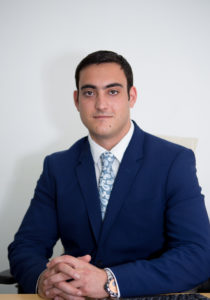Through 3D printing technology, industry can reap tremendous returns by rapidly creating more innovative products and streamlining manufacturing processes, says Managing Director Alexander Papantoniou.
 People are discussing how it’s going to replace traditional manufacturing and change the world,” Alexander Papantoniou, Managing Director of D2M Solutions, said of 3D printing, the technology at the heart of his business’ solutions portfolio. However, he added: “Whilst 3D printing is already changing the world – particularly in the medical and aerospace fields, it’s unlikely that it will replace mass manufacturing in the near future, when really large volumes of products are needed. Presently, it is disrupting manufacturing by means of plugging a gap, in cases where you have low-volume, high-complexity parts. However, we must be ready to see a paradigm shift in the way products are designed and manufactured, as 3D printing opens up unprecedented new freedoms. A possible scenario is on-demand design and manufacturing of consumer products.”
People are discussing how it’s going to replace traditional manufacturing and change the world,” Alexander Papantoniou, Managing Director of D2M Solutions, said of 3D printing, the technology at the heart of his business’ solutions portfolio. However, he added: “Whilst 3D printing is already changing the world – particularly in the medical and aerospace fields, it’s unlikely that it will replace mass manufacturing in the near future, when really large volumes of products are needed. Presently, it is disrupting manufacturing by means of plugging a gap, in cases where you have low-volume, high-complexity parts. However, we must be ready to see a paradigm shift in the way products are designed and manufactured, as 3D printing opens up unprecedented new freedoms. A possible scenario is on-demand design and manufacturing of consumer products.”
D2M has been at the forefront in the region in helping companies to realise the digitisation of their complete value chain, bringing a close integration between the virtual and physical world. According to the 29-year-old MD, D2M covers “the entire design-to-manufacturing spectrum which includes software – product lifecycle management for digital product creation, testing and simulation, and also 3D scanners and 3D printers that all help to optimise the product development process.”
In fact, D2M was one of the world’s first distributors for 3D-printing mainstay Stratasys, and was initially based in Cyprus. So the company has managed to build its knowledge in supplying advanced 3D technologies and has become somewhat a pioneer in the Middle East region.
“In May 2010, we moved to the UAE because our customers were mainly GCC entities,” Papantoniou explained. “Our biggest markets by far are the UAE and Saudi Arabia, but we cover all Gulf states. With these markets, obviously there’s always a drive to show innovation, and this technology plays a key role in sectors such as medical, aerospace, defence, and education – pretty much any industry where 3D design and manufacturing data is used. We recognised early on that the region would need to make a switch from the “contract manufacturing model” to added-value manufacturing if they wanted to create innovative products that would add-value to their business. To ccomplish this new model, it’s important that companies can fully integrate digital technologies with all their processes, otherwise they will be hard pressed to compete. We have witnessed first-hand how the drive to diversify from the oil-based economy and expand industrial manufacturing have seen keen interest in transformative digital technologies – basically they provide the core for successful product development. ”
REMOVING CONSTRAINTS
“With 3D printing, you have very few design constraints, so whether it’s plastic, metal or any other material, you are building the model layer by layer, and you don’t have the traditional manufacturing
limitations that you have with other technologies,” said Papantoniou. “This allows you to make components with less parts and less assembly – which is more time and material efficient – and with
freedom of design, meaning you can push the innovation envelope a bit further.”
D2M’s service branch, Paradigm 3D is a full in-house 3D services and consultancy facility, and its engineering team specialise in a number of disciplines, from 3D design and 3D scanning to CNC machining, casting and 3D printing. The company proudly claims “the largest footprint for 3D printers in the Middle East” and is part of a global manufacturing network of more than 200 systems called Stratasys Direct Manufacturing.
We can offer any services in 3D-printing technology available on the market today,” Papantoniou said. “So if in exceptional cases, we don’t have something
in-house, we can always tap into our extended network to offer the requirements.
“In our production area we have four large production 3D printers, based on FDM (fused deposition modelling) technology, one of them being the biggest in the UAE, with a building envelope of 60 x 90 x 90cm, said Papantoniou. “We also offer a technology called Polyjet, which is ideal for medical models. In terms of quality guarantees, it depends what the customer is looking for. In a part we made for an airline, we managed to make it four times stronger and 40 per cent lighter, which for the aviation industry, obviously, is a huge bonus.”
SPARES ON DEMAND
D2M’s largest industrial markets lie in aerospace and defence, where it focuses on an area called on-demand spare parts – the ability to rapidly reverse-engineer and reproduce a component. With the
approach of Dubai’s hosting of World Expo 2020, Papantoniou is also encouraged by recent developments in the country.
“Traditionally in this region ‘under license’ manufacturing was the norm, but the value-add was very little when you are just producing products from third parties,” he said. “Now people are starting to catch on to this and with the drive for innovation in the region , they are moving towards a business model of value-added manufacturing – where they are designing and developing their own products, maintaining a much higher margin, therefore creating sustainability and growth for their businesses.”
D2M commits a hefty percentage of its operational focus to research and development of applications of the technologies, in order to provide transfer of know-how to its customers.
“This is best illustrated by the aerospace sector,” Papantoniou explained. “Anywhere else in the world, behind the airlines or the original equipment manufacturers (OEMs), you have a tier-structure of aerospace suppliers that know what they want, because they’ve been in business for many years. They
can come to you with extremely tight specifications. But in this region, we are talking directly to the end user, which means that, a lot of times, because they haven’t been exposed to the technology before, we have to start re-inventing from scratch. Some of our projects can take up to two years, until we’ve satisfied all the certification, process and quality ALEXANDER PAPANTONIOU – requirements.”
TESTING THE WATER
Citing the example of metal printing, which has gained recent media attention after General Electric made a jet engine exclusively from 3D-printed parts, Papantoniou remarked: “Metal printing is an industry that is gaining steam, but whenever you’re discussing replacing a metal component, you need to look at certification very closely. If you’re an OEM, that’s okay because you can certify your own parts, but for someone to think they can buy a metal printer and start making jet engines, is a far away dream.
To give you an example, even the plastic material used in the cabins of aircraft, took about 10 or 15 years to attain industry certification, and these are non-critical components.”
But Papantoniou still believes end-user returns come much faster from manufacturing than from expensive prototyping, which was one of the principle reasons D2M set up its service bureau, Paradigm
3D – to allow customers to test the waters without significant investment.
“Because of the low oil price, customers are hesitant about investing in equipment they don’t fully understand, so we combat this with provision of our services,” Papantoniou explained.
D2M’s expansion plans include a bold new offering in which the company will set up complete factories, based on the concept of on-demand manufacturing. “The building; all the equipment; all the technologies necessary to produce components in plastic, composite and a variety of metals; software; hardware; training; and even the sourcing of people will be handled by us on behalf of the customer,” Papantoniou said.
“Again this is particularly related to defence because they have the biggest need for spare parts. This offers users tremendous returns; even though it’s a sizeable investment, the ability to reduce stock and combat obsolete components is a huge issue at the moment.”

